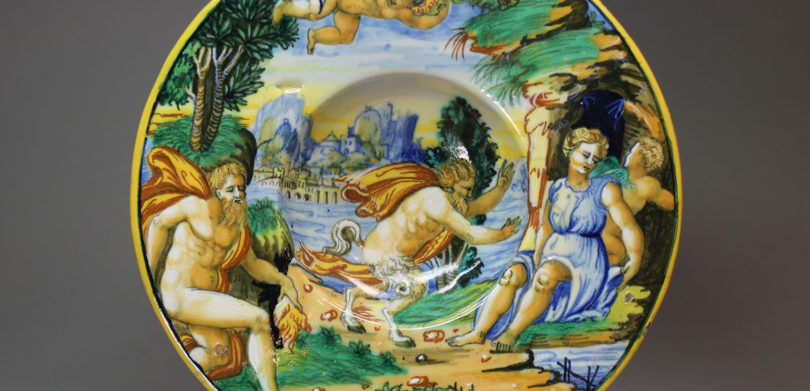Like a talented storyteller beginning his tale, a generous host invites visitors into the scene by setting the table with delicious food and decorated dinnerware. In Renaissance Italy, maiolica was the standard form of pottery used to serve these welcoming meals. The exhibition “Storytelling in Renaissance Maiolica,” on view at the Georgia Museum of Art at the University of Georgia April 27 until Jan. 5, 2020, contains several of these tin-glazed earthenware plates from 16th-century Urbino and Venice.
The catalyst for the exhibition was two pieces of maiolica the museum recently purchased with funds provided by the Virginia Y. Trotter Decorative Arts Endowment and the William Underwood Eiland Endowment. These works were made in the workshop of Guido Durantino (also known as Guido Fontana; active 1520 – 1576) and his son Orazio in Urbino, Italy. Perri Lee Roberts, professor emeritus, University of Miami, and guest curator for the exhibition, helped locate them, as well as other works borrowed for the exhibition.
Nelda Damiano, Pierre Daura Curator of European Art and in-house curator of the exhibition, said, “The two dishes, representing mythological subjects, were purchased on the London art market, at a time when maiolica is experiencing a renewed interest and major exhibitions are highlighting its beauty and art historical value. We are extremely proud to share with our visitors maiolica examples of such high quality, produced in one of the most important workshops of the period.
Islamic potters first developed the process of making maiolica around 800 BCE, emulating Chinese white porcelain. Islamic rule in Spain from the 8th to the 15th century spread the technique to Europe, including Italy. The technique requires covering a fired ceramic with a white glaze containing tin oxide. The result is a blank slate for decorating. Decorating this surface requires skill and determination. Fused glaze does not forgive mistakes. The final product is durable and remains bright and colorful for centuries. The plates in the exhibition, which come from lenders including the Cummer Museum of Art & Gardens, the Gardiner Museum, the Speed Art Museum and the Virginia Museum of Fine Arts, include a variety of colors from bright blue to sandy orange. During the Renaissance, Italian maiolica was affordable and sold at a large commercial scale.
The stories shown on these plates would have been familiar to contemporary audiences and often come from classical mythology or the Bible. The two pieces that the museum purchased depict mythological subjects from Ovid’s Metamorphoses, a Roman narrative poem. In designing complex, figurative compositions and three-dimensional settings, artists often derived inspiration from prints and illustrations. Dining was considered one of the most important social activities of aristocratic life—an ideal occasion to demonstrate one’s elevated status, good taste, and erudition. Banquets featured multiple courses that required a large number of serving pieces to present and distribute the food, which was eaten with one’s hands. In composing the painted narratives, artists often exploited the varying surfaces and depressions of the piece on which it appeared to reveal the story sequentially, enhancing the impact of the imagery as the diner emptied the dish. Inscriptions appear on the backs of many pieces of historiated maiolica—recording the subject matter, date, site of production, artist, and excerpts from poetry—suggesting that diners might have turned them over during meals for more information.
Related events at the museum include:
- A public tour of the exhibition with Pierre Daura Curator of European Art Nelda Damiano on June 12 and Sept. 4 at 2 p.m.
- 90 Carlton: Summer, the museum’s quarterly reception, on July 19 from 5:30 to 7:30 p.m. (free for current members, $10 for Friends of the Museum and Supporters, $15 for Not Yet Friends; galleries open until 8:30 p.m.)
- A lecture by guest curator Perri Lee Roberts on Aug. 23 at 2:30 p.m.
- A lecture by Elena Bianchelli, senior lecturer and director of the Rome Program, UGA department of classics (time and date to be determined)
All programs are free and open to the public unless otherwise indicated.







